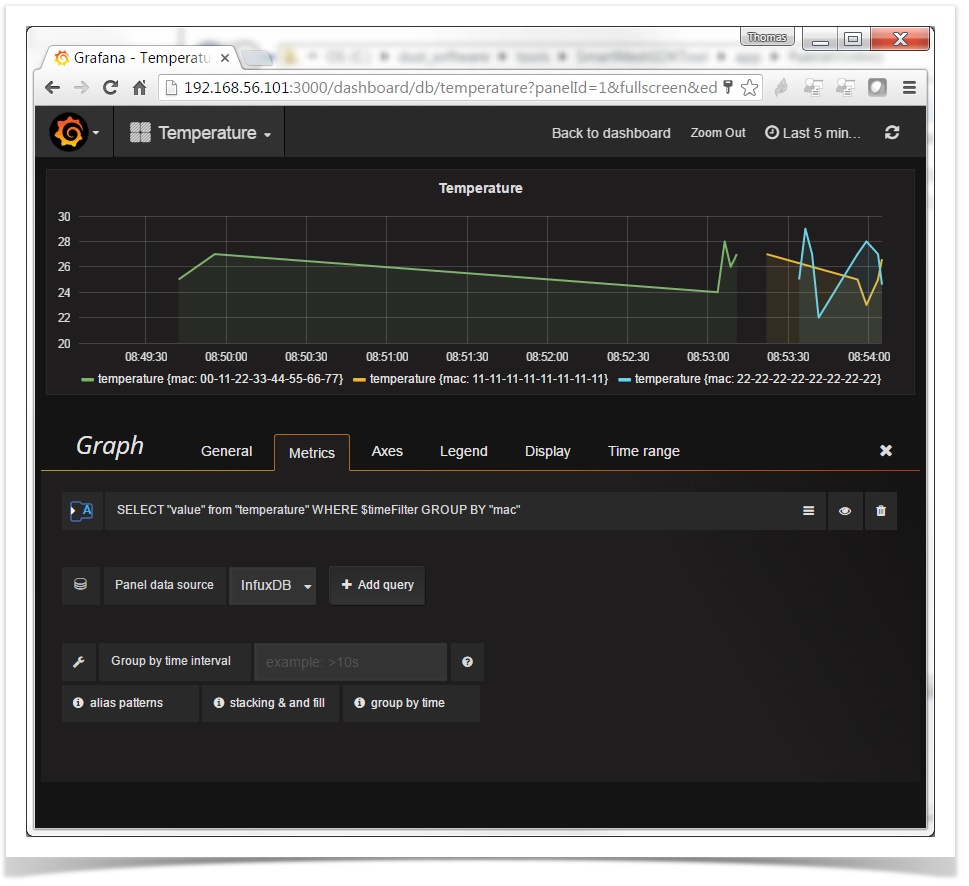| Gliffy | ||
|---|---|---|
|
| Info | ||
|---|---|---|
|
...
Once installed, log into the server.
Update
...
| Note |
|---|
The commands above update your entire OS. This can take 10-15min. |
SSH
Install the OpenSSH server:
...
Add your public key to the server:
...
Edit /etc/ssh/sshd_config so it contains the following (un-commented) lines:
...
Restart the SSH server:
...
influxdb
install database
Install and start InfluxDB automatically:
...
You should see the InfluxDB admin panel at http://192.168.56.101:8083/.
| Tip |
|---|
By default, the HTTP API of InfluxDB runs on TCP port 8086. |
create database
Use the influx client to create a database "grafana" and associate a retention policy so datapoints are automatically deleted after 12 hours:
...
Recent versions of the influxdb package include the command-line client. If your distribution has an older package, you may need to install the client separately.
...
grafana
install
The following commands install grafana, start it, and ensure it also starts on the next boot:
...
You should now be able to see the Grafana front end running at http://192.168.56.101:3000/.
| Note |
|---|
We are not using authentication between Grafana and InfluxDB, but you still have to provide a username/password in the "InfluxDB Details" section below. |
change admin username and password
Connect to the Grafana front end with username "admin" and password "admin". Though the profile page, change both the username and password associated with the Grafana administrator.
connect to database
Through the admin interface, add InfluxDB as a data source. From the drop down menu in the upper left, choose Data Sources and click on Add data source.
create dashboard
Through the admin interface, create a new dashboard named Temperature. From the drop down menu in the upper left, select Dashboards → New. The first row is already created, indicated by the vertical line on the left edge. Hovering over that indicator will reveal a menu for editing. Select Add Panel → Graph to create a graph of the temperature data. Under Metrics, select Toggle edit mode under the drop down menu (on the right next to the eye icon) to change the input mode so you can paste in the following query:
...
...
To verify everything works, on the Admin interface of InfluxDB (http://192.168.56.101:8083/), select the "grafana" database, click "Write Data" and enter:
...
enable anonymous access
Change the /etc/grafana/grafana.ini file so it contains the following lines:
...
set as default dashboard
- log into Grafana as admin
- star the dashboard you create
- in the dropdown menu, edit the setting for the default organization, and set the dashboard as default home dashboard
clouddata_server script
install Python
...
install clouddata_server script
You can download the cloudata_server.py script as part of the SMSDK. You will find it in the app/PublishToWeb/ directory.
Install the Python dependencies of the SmartMesh SDK:
...
run at startup
Install supervisor:
...
Create a new file for supervisor to manage the clouddata_server process:
...
Include the following contents, where _USER_ is replaced with the current username:
...
Start the supervisor daemon and configure the daemon to start when the system is booted:
...
NGINX
installation
...
| Tip |
|---|
|
configuration
We will use nginx in proxy mode. The role is that it redirects per the table below:
...
...
Create file /etc/nginx/sites-available/clouddata_server with the following contents:
...
Install the script:
| Code Block |
|---|
Restart the server:
...
iptables
| Note |
|---|
It is important you step through the |
configure
Type the following commands in this order to configure iptables (the firewall):
| Code Block | ||
|---|---|---|
|
There lines have the following actions (respectively):
- [line 1] all ports are open for communication internal to the server (needed for the communication between grafana, influxdb, and
clouddata_server) - [line 2] accept incoming SSH traffic (needed for you to configure the server later on)
- [line 3] accept incoming HTTP traffic (needed for a client to push sensor data and see the grafana web interface)
- [lines 4,5,6,7] allow outgoing DNS queries
- [lines 8,9] allow outgoing HTTP traffic (needed for example to use
apt-get) - [lines 10,11] allow incoming ping requests (needed so you can ping your server)
- [lines 12,13] allow outgoing ping requests (needed so from the server you can ping other hosts to verify connectivity)
- [line 14] drop all other incoming traffic
verify
Type the following command to verify all rules are active:
...
run at boot
| Info |
|---|
By default, your |
Install the iptables-persistent package:
...
At installation, make sure to click "yes" to save the current IPv4 and IPv6 rules
Testing
Once you have the server running, you can test it by using the following scripts:
PublishRandom.pypublishes a random temperature coming from a (fake) random MAC addressPublishToWeb.py
...



